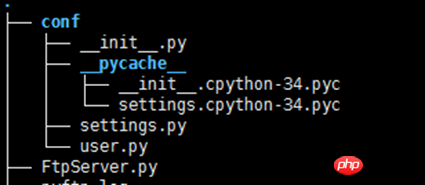How to implement FTP server service in Python (Collection)
This article mainly introduces the method of implementing FTP server in python. The editor thinks it is quite good. Now I will share it with you and give it as a reference. Let’s follow the editor to take a look.
Active mode and passive mode of FTP service
Before we start, let’s talk about the active mode and passive mode of FTP. The difference between them may be more clear by using two pictures:
Active mode:

Active mode working process:
1. The client initiates a connection to the server port 21 using a random non-privileged port N, which is a port greater than 1024.
2. The client starts listening to port N+1;
3. The server will actively connect to the client’s N+1 port through port 20.
Advantages of active mode:
The server configuration is simple, which is conducive to server security management. The server only needs to open port 21
Active mode Disadvantages:
If the client has a firewall turned on, or the client is on the intranet (behind a NAT gateway), the connection initiated by the server to the client port may fail
Passive Mode:

Passive mode working process:
1. The client connects to port 21 of the server through a random unprivileged port
2. The server opens an unprivileged port as a passive port and returns it to the client
3. The client actively connects to the server's passive port using the unprivileged port + 1 port
Disadvantages of passive mode:
Server configuration management is slightly complicated, which is not conducive to security. The server needs to open random high-level ports so that clients can connect, so most FTP service software can manually configure the passive port range
Passive Advantages of the mode: There are no requirements for the client network environment
After understanding FTP, start using python to implement FTP services
Preparation work
This The python version used for the first time: python 3.4.3
Install the module pyftpdlib
##
pip3 install pyftpdlib
Implement simple local verification
from pyftpdlib.authorizers import DummyAuthorizer from pyftpdlib.handlers import FTPHandler from pyftpdlib.servers import FTPServer #实例化虚拟用户,这是FTP验证首要条件 authorizer = DummyAuthorizer() #添加用户权限和路径,括号内的参数是(用户名, 密码, 用户目录, 权限) authorizer.add_user('user', '12345', '/home/', perm='elradfmw') #添加匿名用户 只需要路径 authorizer.add_anonymous('/home/huangxm') #初始化ftp句柄 handler = FTPHandler handler.authorizer = authorizer #监听ip 和 端口,因为linux里非root用户无法使用21端口,所以我使用了2121端口 server = FTPServer(('192.168.0.108', 2121), handler) #开始服务 server.serve_forever()
Start the service
$python FtpServer.pyTest Try:

Add passive ports through the following code:
handler.passive_ports = range(2000, 2333)Full code:from pyftpdlib.authorizers import DummyAuthorizer from pyftpdlib.handlers import FTPHandler from pyftpdlib.servers import FTPServer #实例化虚拟用户,这是FTP验证首要条件 authorizer = DummyAuthorizer() #添加用户权限和路径,括号内的参数是(用户名, 密码, 用户目录, 权限) authorizer.add_user('user', '12345', '/home/', perm='elradfmw') #添加匿名用户 只需要路径 authorizer.add_anonymous('/home/huangxm') #初始化ftp句柄 handler = FTPHandler handler.authorizer = authorizer #添加被动端口范围 handler.passive_ports = range(2000, 2333) #监听ip 和 端口 server = FTPServer(('192.168.0.108', 2121), handler) #开始服务 server.serve_forever()
$ python FtpServer.py [I 2017-01-11 15:18:37] >>> starting FTP server on 192.168.0.108:2121, pid=46296 <<< [I 2017-01-11 15:18:37] concurrency model: async [I 2017-01-11 15:18:37] masquerade (NAT) address: None [I 2017-01-11 15:18:37] passive ports: 2000->2332
FTP user management:
Through the above practice, the FTP server can already work normally, but what if many FTP users are needed? Should each user write it once? In fact, we can define a user file user.py#用户名 密码 权限 目录 # root 12345 elradfmwM /home huangxm 12345 elradfmwM /home
from pyftpdlib.authorizers import DummyAuthorizer
from pyftpdlib.handlers import FTPHandler
from pyftpdlib.servers import FTPServer
def get_user(userfile):
#定义一个用户列表
user_list = []
with open(userfile) as f:
for line in f:
print(len(line.split()))
if not line.startswith('#') and line:
if len(line.split()) == 4:
user_list.append(line.split())
else:
print("user.conf配置错误")
return user_list
#实例化虚拟用户,这是FTP验证首要条件
authorizer = DummyAuthorizer()
#添加用户权限和路径,括号内的参数是(用户名, 密码, 用户目录, 权限)
#authorizer.add_user('user', '12345', '/home/', perm='elradfmw')
user_list = get_user('/home/huangxm/test_py/FtpServer/user.conf')
for user in user_list:
name, passwd, permit, homedir = user
try:
authorizer.add_user(name, passwd, homedir, perm=permit)
except Exception as e:
print(e)
#添加匿名用户 只需要路径
authorizer.add_anonymous('/home/huangxm')
#初始化ftp句柄
handler = FTPHandler
handler.authorizer = authorizer
#添加被动端口范围
handler.passive_ports = range(2000, 2333)
#监听ip 和 端口
server = FTPServer(('192.168.0.108', 2121), handler)
#开始服务
server.serve_forever()Standardize the code
First create the conf directory to store settings.py and user.pyDirectory structure (don’t worry about the cache):
ip = '0.0.0.0' port = '2121' #上传速度 300kb/s max_upload = 300 * 1024 #下载速度 300kb/s max_download = 300 * 1024 #最大连接数 max_cons = 150 #最多IP数 max_per_ip = 10 #被动端口范围,注意被动端口数量要比最大IP数多,否则可能出现无法连接的情况 passive_ports = (2000, 2200) #是否开启匿名访问 on|off enable_anonymous = 'off' #匿名用户目录 anonymous_path = '/home/huangxm' #是否开启日志 on|off enable_logging = 'off' #日志文件 loging_name = 'pyftp.log' #欢迎信息 welcome_msg = 'Welcome to my ftp'
#用户名 密码 权限 目录 #root 12345 elradfmwM /home/ huangxm 12345 elradfmwM /home/ test 12345 elradfmwM /home/huangxm
##
from pyftpdlib.authorizers import DummyAuthorizer
from pyftpdlib.handlers import FTPHandler, ThrottledDTPHandler
from pyftpdlib.servers import FTPServer
from conf import settings
import logging
def get_user(userfile):
#定义一个用户列表
user_list = []
with open(userfile) as f:
for line in f:
if not line.startswith('#') and line:
if len(line.split()) == 4:
user_list.append(line.split())
else:
print("user.conf配置错误")
return user_list
def ftp_server():
#实例化虚拟用户,这是FTP验证首要条件
authorizer = DummyAuthorizer()
#添加用户权限和路径,括号内的参数是(用户名, 密码, 用户目录, 权限)
#authorizer.add_user('user', '12345', '/home/', perm='elradfmw')
user_list = get_user('conf/user.py')
for user in user_list:
name, passwd, permit, homedir = user
try:
authorizer.add_user(name, passwd, homedir, perm=permit)
except Exception as e:
print(e)
#添加匿名用户 只需要路径
if settings.enable_anonymous == 'on':
authorizer.add_anonymous(settings.anonymous_path)
#下载上传速度设置
dtp_handler = ThrottledDTPHandler
dtp_handler.read_limit = settings.max_download
dtp_handler.write_limit = settings.max_upload
#初始化ftp句柄
handler = FTPHandler
handler.authorizer = authorizer
#日志记录
if settings.enable_logging == 'on':
logging.basicConfig(filename=settings.loging_name, level=logging.INFO)
#欢迎信息
handler.banner = settings.welcome_msg
#添加被动端口范围
handler.passive_ports = range(settings.passive_ports[0], settings.passive_ports[1])
#监听ip 和 端口
server = FTPServer((settings.ip, settings.port), handler)
#最大连接数
server.max_cons = settings.max_cons
server.max_cons_per_ip = settings.max_per_ip
#开始服务
print('开始服务')
server.serve_forever()
if __name__ == "__main__":
ftp_server()Finally, let’s talk about the permission issue
Read permission:
| Change file directory | |
| List files | |
| Receive files from server |
| d | |
| f | |
| m | |
| w | |
| M | |
The above is the detailed content of How to implement FTP server service in Python (Collection). For more information, please follow other related articles on the PHP Chinese website!

Hot AI Tools

Undresser.AI Undress
AI-powered app for creating realistic nude photos

AI Clothes Remover
Online AI tool for removing clothes from photos.

Undress AI Tool
Undress images for free

Clothoff.io
AI clothes remover

AI Hentai Generator
Generate AI Hentai for free.

Hot Article

Hot Tools

Notepad++7.3.1
Easy-to-use and free code editor

SublimeText3 Chinese version
Chinese version, very easy to use

Zend Studio 13.0.1
Powerful PHP integrated development environment

Dreamweaver CS6
Visual web development tools

SublimeText3 Mac version
God-level code editing software (SublimeText3)

Hot Topics
 Is the conversion speed fast when converting XML to PDF on mobile phone?
Apr 02, 2025 pm 10:09 PM
Is the conversion speed fast when converting XML to PDF on mobile phone?
Apr 02, 2025 pm 10:09 PM
The speed of mobile XML to PDF depends on the following factors: the complexity of XML structure. Mobile hardware configuration conversion method (library, algorithm) code quality optimization methods (select efficient libraries, optimize algorithms, cache data, and utilize multi-threading). Overall, there is no absolute answer and it needs to be optimized according to the specific situation.
 Is there any mobile app that can convert XML into PDF?
Apr 02, 2025 pm 08:54 PM
Is there any mobile app that can convert XML into PDF?
Apr 02, 2025 pm 08:54 PM
An application that converts XML directly to PDF cannot be found because they are two fundamentally different formats. XML is used to store data, while PDF is used to display documents. To complete the transformation, you can use programming languages and libraries such as Python and ReportLab to parse XML data and generate PDF documents.
 How to convert XML files to PDF on your phone?
Apr 02, 2025 pm 10:12 PM
How to convert XML files to PDF on your phone?
Apr 02, 2025 pm 10:12 PM
It is impossible to complete XML to PDF conversion directly on your phone with a single application. It is necessary to use cloud services, which can be achieved through two steps: 1. Convert XML to PDF in the cloud, 2. Access or download the converted PDF file on the mobile phone.
 What is the function of C language sum?
Apr 03, 2025 pm 02:21 PM
What is the function of C language sum?
Apr 03, 2025 pm 02:21 PM
There is no built-in sum function in C language, so it needs to be written by yourself. Sum can be achieved by traversing the array and accumulating elements: Loop version: Sum is calculated using for loop and array length. Pointer version: Use pointers to point to array elements, and efficient summing is achieved through self-increment pointers. Dynamically allocate array version: Dynamically allocate arrays and manage memory yourself, ensuring that allocated memory is freed to prevent memory leaks.
 How to control the size of XML converted to images?
Apr 02, 2025 pm 07:24 PM
How to control the size of XML converted to images?
Apr 02, 2025 pm 07:24 PM
To generate images through XML, you need to use graph libraries (such as Pillow and JFreeChart) as bridges to generate images based on metadata (size, color) in XML. The key to controlling the size of the image is to adjust the values of the <width> and <height> tags in XML. However, in practical applications, the complexity of XML structure, the fineness of graph drawing, the speed of image generation and memory consumption, and the selection of image formats all have an impact on the generated image size. Therefore, it is necessary to have a deep understanding of XML structure, proficient in the graphics library, and consider factors such as optimization algorithms and image format selection.
 How to open xml format
Apr 02, 2025 pm 09:00 PM
How to open xml format
Apr 02, 2025 pm 09:00 PM
Use most text editors to open XML files; if you need a more intuitive tree display, you can use an XML editor, such as Oxygen XML Editor or XMLSpy; if you process XML data in a program, you need to use a programming language (such as Python) and XML libraries (such as xml.etree.ElementTree) to parse.
 How to convert xml into pictures
Apr 03, 2025 am 07:39 AM
How to convert xml into pictures
Apr 03, 2025 am 07:39 AM
XML can be converted to images by using an XSLT converter or image library. XSLT Converter: Use an XSLT processor and stylesheet to convert XML to images. Image Library: Use libraries such as PIL or ImageMagick to create images from XML data, such as drawing shapes and text.
 Recommended XML formatting tool
Apr 02, 2025 pm 09:03 PM
Recommended XML formatting tool
Apr 02, 2025 pm 09:03 PM
XML formatting tools can type code according to rules to improve readability and understanding. When selecting a tool, pay attention to customization capabilities, handling of special circumstances, performance and ease of use. Commonly used tool types include online tools, IDE plug-ins, and command-line tools.








